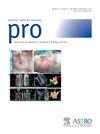Unplanned Emergency Department or Inpatient Acute Care Within 1 Week After Administration of Peptide Receptor Radionuclide Therapy: Frequency of Occurrence and Standard Operating Procedures for Radioprotection in These Situations
IF 3.4
3区 医学
Q2 ONCOLOGY
引用次数: 0
Abstract
Peptide receptor radionuclide therapy (PRRT) is a rapidly developing treatment modality. These treatments are indicated for patients who are either heavily pretreated and/or may have neurohormonal active disease, increasing the risk of acute adverse effects and the need for unplanned acute care. The goals of this report were to characterize the frequency of unplanned acute care utilization after PRRT infusion and detail a comprehensive standard operating procedure (SOP) for radioprotection during unplanned post-PRRT acute care. The records of patients treated with PRRT were reviewed. The event of interest was emergency department (ED) utilization and/or inpatient admission within 7 days of PRRT infusion. A multidisciplinary group developed a radioprotection SOP for all phases of unplanned acute care including the clinical infusion space and emergency medical services transport to the ED, within the ED, and on the inpatient floor. A total of 232 patients received 814 infusions of PRRT, with 134 (58%) receiving Lutathera and 98 (42%) receiving Pluvicto. Nineteen patients received unplanned acute care at an ED within 7 days of PRRT infusion (8% of patients, 2% of infusions), of which 10 received Lutathera (8% of patients, 2% of infusions). Two patients (2% of patients, 0.5% of infusions) experienced carcinoid crises within 24 hours of Lutathera infusion. The median and average intervals between infusion and ED visit were 0.5 days and 1.3 days, respectively. Nine patients received Pluvicto (9% of patients, 3% of infusions). The median and average intervals between infusion and ED visit were 4 and 4.7 days, respectively. Emergency room utilization and/or inpatient admission after PRRT administration are relatively infrequent events, but not unexpected. Centers that administer PRRT should have a comprehensive SOP in place to effectively care for radioactive patient emergencies while maximizing medical staff protection.
肽受体放射性核素治疗后一周内的计划外急诊或住院急诊:肽受体放射性核素治疗后一周内的计划外急诊或急症护理:发生频率和这些情况下的辐射防护标准操作程序。
肽受体放射性核素疗法(PRRT)是一种发展迅速的治疗方式。这些疗法适用于接受过大量预处理和/或可能患有神经激素活动性疾病的患者,增加了急性不良反应的风险和意外急诊护理的需求。本报告旨在描述 PRRT 输注后使用意外急症护理的频率,并详细介绍 PRRT 输注后意外急症护理期间放射防护的综合标准操作程序 (SOP)。对接受 PRRT 治疗的患者的记录进行了审查。关注的事件是输注 PRRT 后 7 天内急诊科 (ED) 的使用情况和/或住院情况。一个多学科小组为意外急诊护理的所有阶段制定了放射防护 SOP,包括临床输液空间、急诊医疗服务 (EMS) 运送到急诊室、急诊室内和住院楼层。共有 232 名患者接受了 814 次 PRRT 输液,其中 134 人(58%)接受了 Lutathera 治疗,98 人(42%)接受了 Pluvicto 治疗。19名患者在输注PRRT后7天内在急诊室接受了计划外急诊治疗(占患者总数的8%,占输液总数的2%),其中10名患者接受了路他他治疗(占患者总数的8%,占输液总数的2%)。两名患者(占患者总数的2%,占输液总数的0.5%)在输注路他他后24小时内出现类癌危象。输液与急诊就诊之间的中位间隔和平均间隔分别为 0.5 天和 1.3 天。9名患者接受了普鲁维托治疗(占患者总数的9%,占输液总数的3%)。输液与急诊就诊之间的中位间隔时间和平均间隔时间分别为 4 天和 4.7 天。进行 PRRT 治疗后使用急诊室和/或住院治疗的情况相对较少,但并非意料之外。实施 PRRT 的中心应制定全面的 SOP,以有效处理放射性病人的紧急情况,同时最大限度地保护医务人员。
本文章由计算机程序翻译,如有差异,请以英文原文为准。
求助全文
约1分钟内获得全文
求助全文
来源期刊

Practical Radiation Oncology
Medicine-Radiology, Nuclear Medicine and Imaging
CiteScore
5.20
自引率
6.10%
发文量
177
审稿时长
34 days
期刊介绍:
The overarching mission of Practical Radiation Oncology is to improve the quality of radiation oncology practice. PRO''s purpose is to document the state of current practice, providing background for those in training and continuing education for practitioners, through discussion and illustration of new techniques, evaluation of current practices, and publication of case reports. PRO strives to provide its readers content that emphasizes knowledge "with a purpose." The content of PRO includes:
Original articles focusing on patient safety, quality measurement, or quality improvement initiatives
Original articles focusing on imaging, contouring, target delineation, simulation, treatment planning, immobilization, organ motion, and other practical issues
ASTRO guidelines, position papers, and consensus statements
Essays that highlight enriching personal experiences in caring for cancer patients and their families.
 求助内容:
求助内容: 应助结果提醒方式:
应助结果提醒方式:


